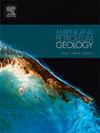Evaluation and modeling of velocity dispersion and frequency-dependent attenuation in gas hydrate-bearing sediments
IF 3.7
2区 地球科学
Q1 GEOSCIENCES, MULTIDISCIPLINARY
引用次数: 0
Abstract
Wave velocity and attenuation of gas hydrate-bearing samples are often extrapolated from ultrasonic to lower seismic/sonic frequencies, but the impact of measurement frequency on these properties is rarely studied. This study evaluates velocity dispersion and frequency-dependent attenuation in gas hydrate-bearing sediments (GHBS) by comparing vertical seismic profile (VSP) and sonic logging data from the Nankai Trough and Mallik field. We also employ rock physics modeling to simulate the velocity dispersion and frequency-dependent attenuation at both sites. The results show strong velocity dispersion and frequency-dependent attenuation in the Nankai Trough, attributed to thin, low-saturation hydrate intervals. In contrast, the Mallik field exhibits weak dispersion and frequency dependence, likely due to thick, highly saturated hydrate layers. A compilation of global hydrate reservoir attenuations indicates frequency dependence, with a peak in the sonic logging range, likely due to pore-scale hydrate effects. These findings emphasize the necessity of considering the effect of measurement frequency when performing time-to-depth conversion for seismic data based on the sonic velocity at higher frequencies, particularly for thin and lowly saturated hydrate layers, thereby improving the accuracy of hydrate reservoir characterization.
含天然气水合物沉积物中速度弥散和频率衰减的评估与建模
含天然气水合物样本的波速和衰减经常从超声波推断到较低的地震/声波频率,但很少研究测量频率对这些特性的影响。本研究通过比较南海海槽和 Mallik 油田的垂直地震剖面 (VSP) 和声波测井数据,评估了含天然气水合物沉积物 (GHBS) 的速度频散和频率衰减。我们还利用岩石物理模型模拟了这两个地点的速度频散和频率衰减。结果显示,南海海槽的速度频散和频率衰减很强,这归因于薄的低饱和度水合物区间。与此相反,Mallik 油田显示出较弱的频散和频率相关性,这可能是由于水合物层较厚、饱和度较高所致。全球水合物储层衰减汇编显示了频率依赖性,在声波测井范围内有一个峰值,这可能是由于孔隙尺度的水合物效应。这些发现强调,在根据较高频率的声波速度对地震数据进行时间-深度转换时,有必要考虑测量频率的影响,特别是对于薄而饱和度低的水合物层,从而提高水合物储层特征描述的准确性。
本文章由计算机程序翻译,如有差异,请以英文原文为准。
求助全文
约1分钟内获得全文
求助全文
来源期刊

Marine and Petroleum Geology
地学-地球科学综合
CiteScore
8.80
自引率
14.30%
发文量
475
审稿时长
63 days
期刊介绍:
Marine and Petroleum Geology is the pre-eminent international forum for the exchange of multidisciplinary concepts, interpretations and techniques for all concerned with marine and petroleum geology in industry, government and academia. Rapid bimonthly publication allows early communications of papers or short communications to the geoscience community.
Marine and Petroleum Geology is essential reading for geologists, geophysicists and explorationists in industry, government and academia working in the following areas: marine geology; basin analysis and evaluation; organic geochemistry; reserve/resource estimation; seismic stratigraphy; thermal models of basic evolution; sedimentary geology; continental margins; geophysical interpretation; structural geology/tectonics; formation evaluation techniques; well logging.
 求助内容:
求助内容: 应助结果提醒方式:
应助结果提醒方式:


